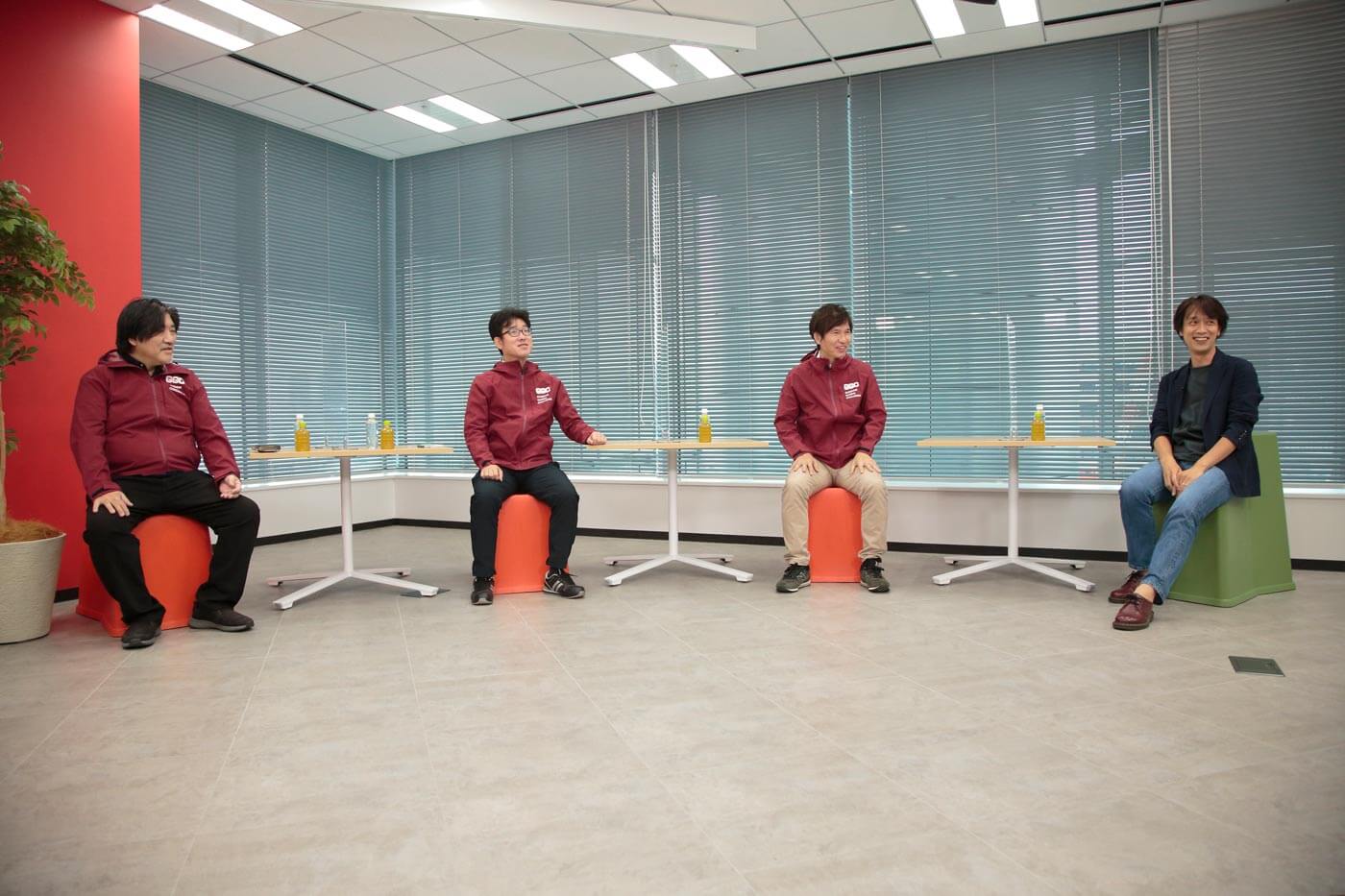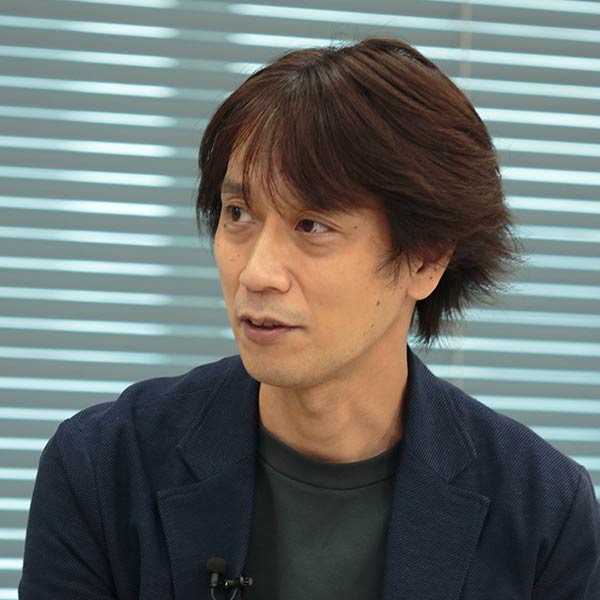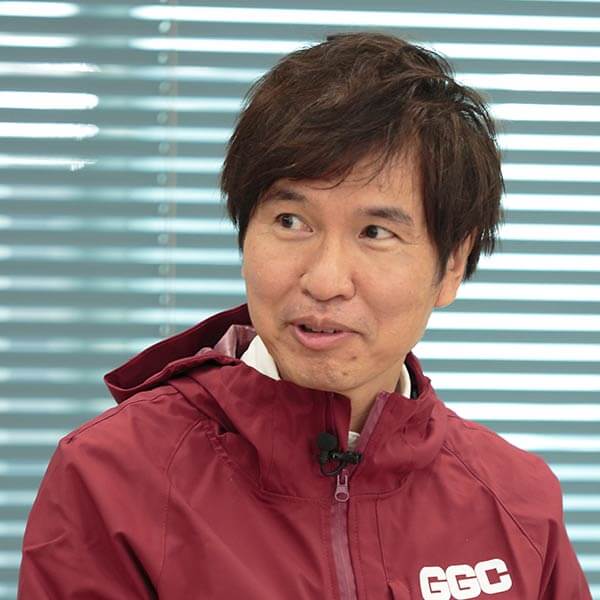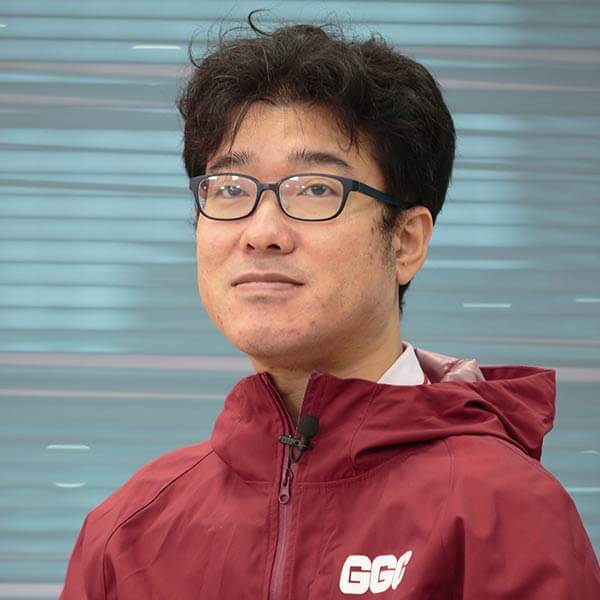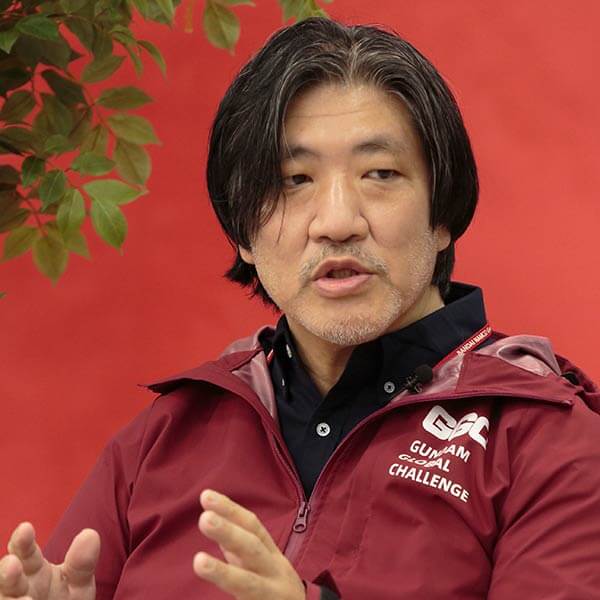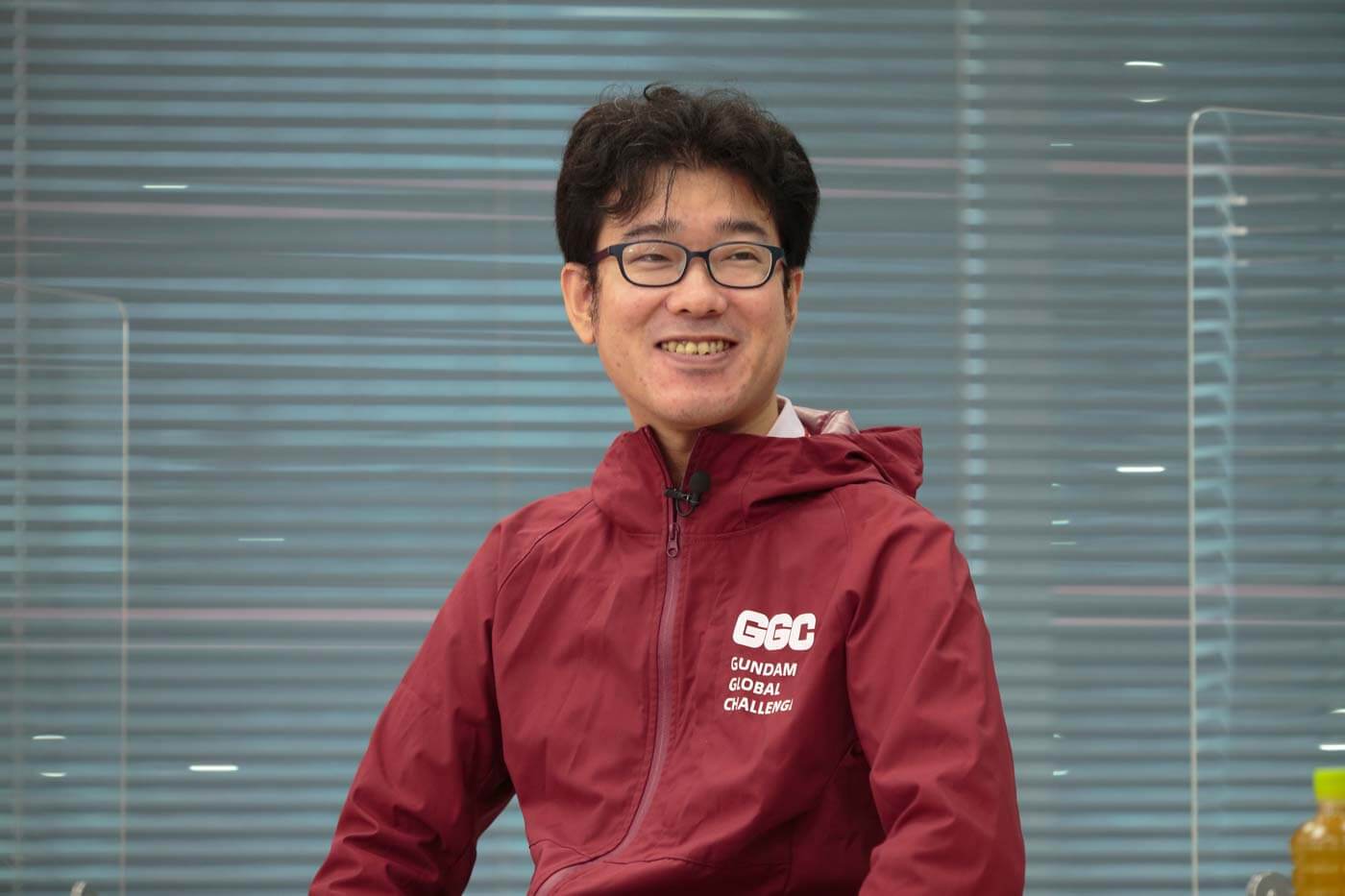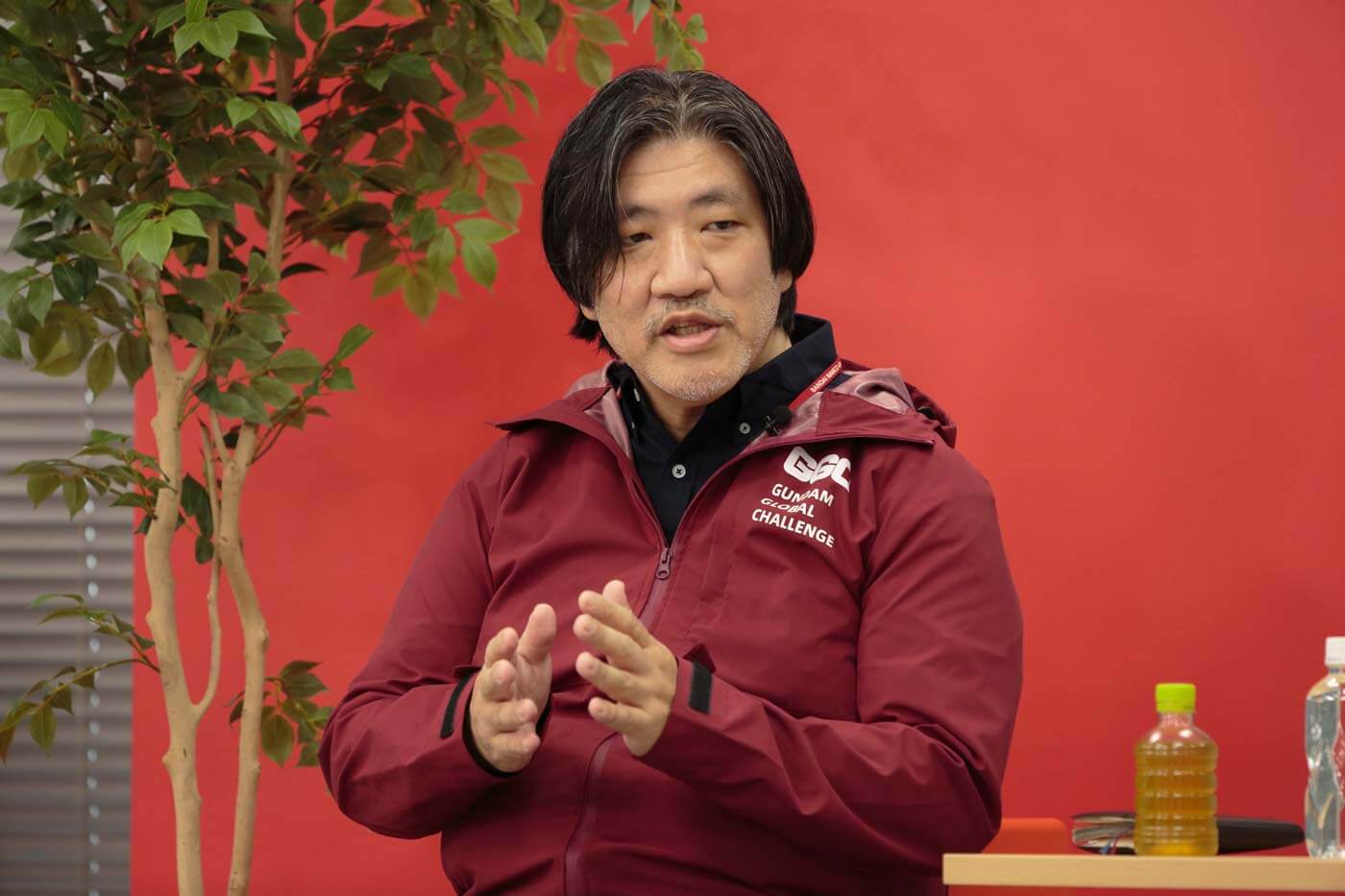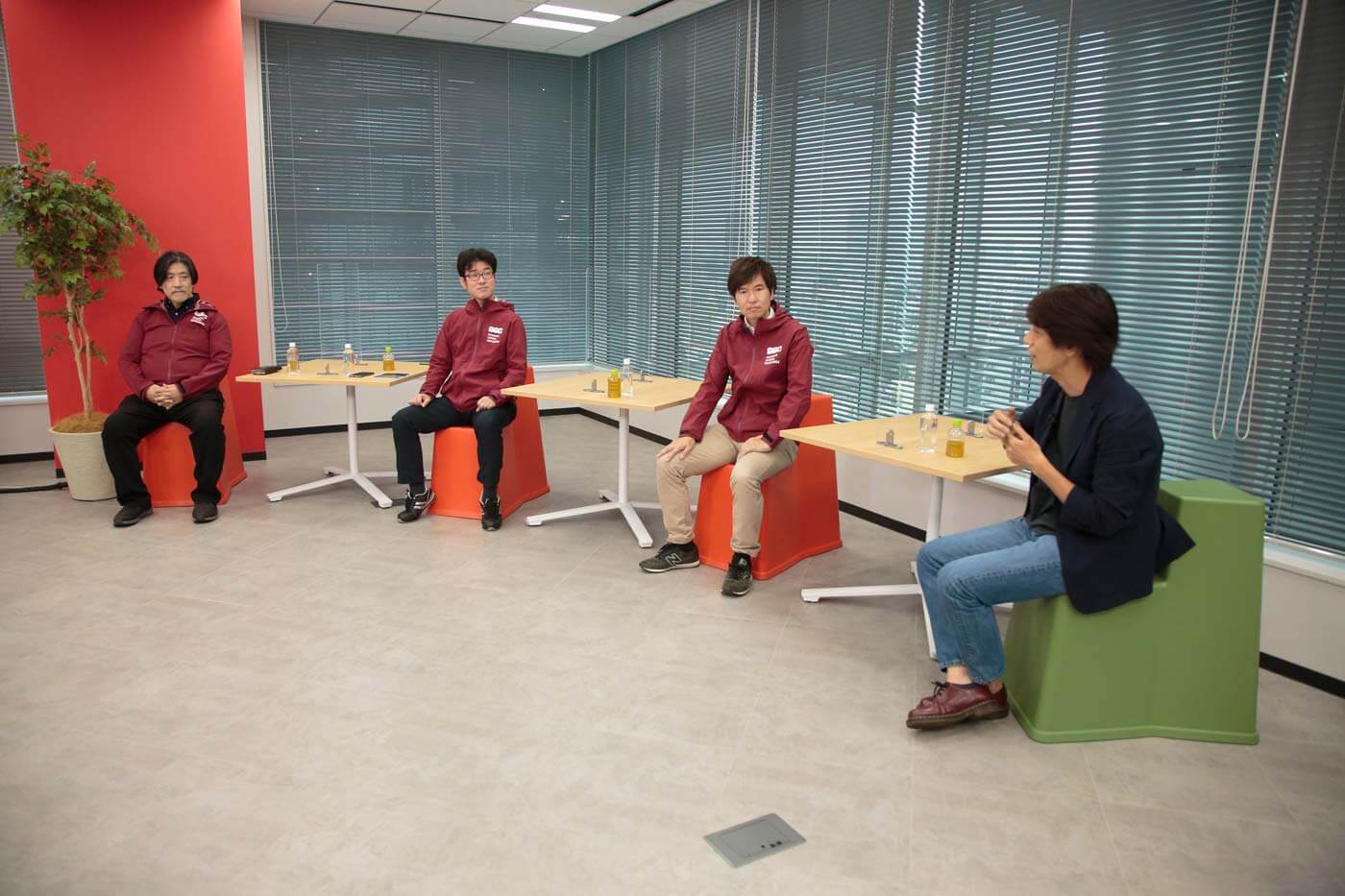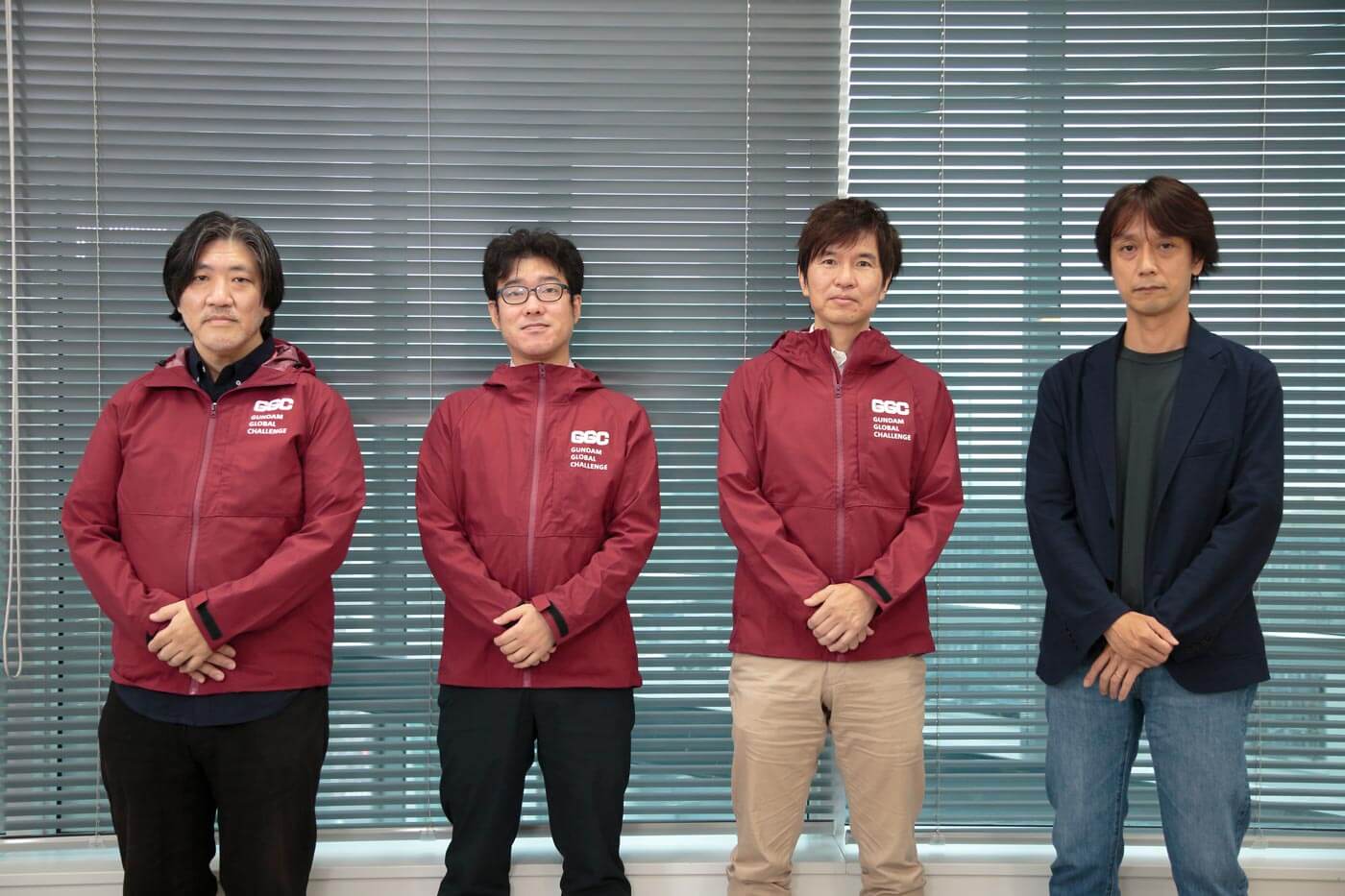Gundam Moved Because True Gundam Fans Banded Together
To kick off our session, could you briefly explain Gundam Open Innovation? Also, could you tell us about how it is related to the "Moving Mobile Suit Gundam" project in Yokohama?
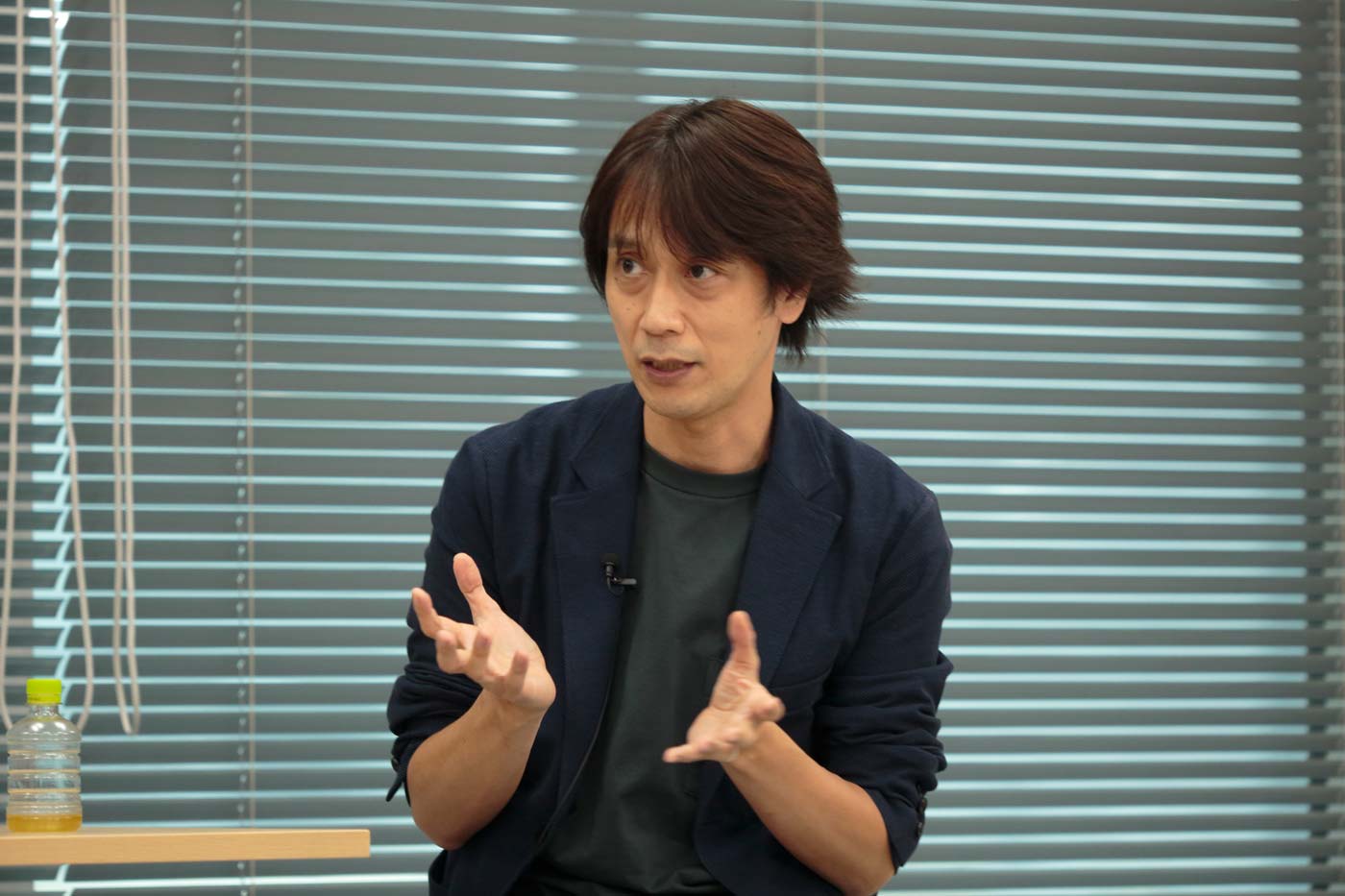
FUJIWARA : Bandai Namco Group launched a new initiative called Gundam Open Innovation (GOI). This aims to solve various social issues by conducting research on technologies and elements that appear in "Universal Century" a fictional era that appears in Gundam, together with Bandai Namco Group, and implementing the results in society. As such, we are accepting a wide range of proposals.
The main objective of GOI is to address Gundam character's appeal through the initiative and to spread it to the world. I think the "Moving Mobile Suit Gundam" project in Yokohama was an iconic event for GOI. Because everyone invovled loves Gundam, they were very proactive about taking up the "Moving GUNDAM" challenge.
Through this, we believe that we have been able to present new value to our customers as extremely new entertainment. How was your experience participating in "Moving GUNDAM"? I'm sure there were various hurdles.
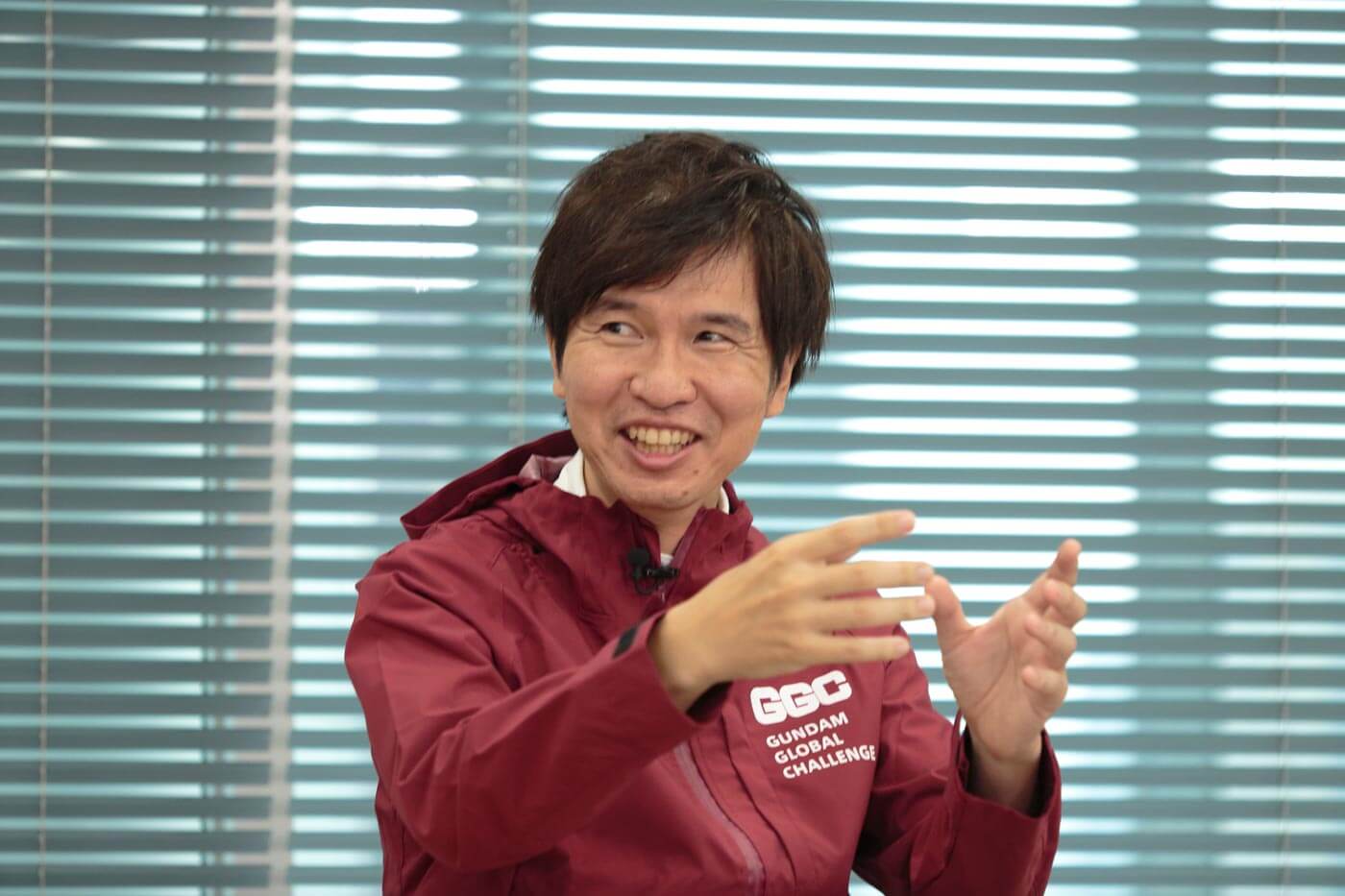
ISHII : In “Moving GUNDAM”, I was in charge of designing the mechanism while coordinating the entire development. The biggest challenge in Moving a life-size Gundam was how to balance design and movement. I talked with Mr. Kawamura on how far we can arrange it so that we don’t lose the uniqueness of Gundam. I had Mr. KAWAHARA change the design, while I made adjustments to the mechanics.
KAWAHARA : Yes, well, I guess it was about a year and a half?
ISHII : The designing process was like a game of cath. To give an example, in "Moving GUNDAM", a motor is installed in the center of the shin to move the ankle joint.The motor would have stuck out if we adopted the normal configuration for installing a motor and gears. Mr. KAWAHARA asked if we should add a cover, but that would ruin the Gundam-ness. In the end, I designed the frame of the shin so that the motor can be installed within the frame.
As for the abdominal frame, I had to provide space for the cockpit. It was decided in the early stage of the project that nobody will be riding inside the Moving GUNDAM. So, there was no need to provide a cockpit. However, I always thought that the main identity of Gundam is that it is "piloted machine”. Therefore, I made provisions in the abdominal frame design to accommodate the cockpit from the beginning.
FUJIWARA : I see. So that was the situation. What about for you, Mr. Yoshizaki?
YOSHIZAKI : I was in charge of overall system design and software development, equivalent to the motor nervous system of humans. One feature of this project was that we ran simulations as to how GUNDAM should move to make it look cool in early stages of the project before its designing was completed; which was my main job in the early stage.
The biggest issue was that no one had attempted to make a 18-m robot move. There is nothing that I can refer to. So, I looked at control systems used at amusement parks and show control systems used in events. In addition, I personally developed a system to move a robot that was about 4m tall. My basic thought was that if I combined those, I should be able to come up with a stable robot system that can be used in a show.
FUJIWARA : Did you have any goals for GUNDAM's movements?
YOSHIZAKI : I thought that the interaction with humans will be most important. The GUNDAM’s to date were all statutes that people looked up to. However, in this project, people may look down to it from an observation deck or look at a kneeling Gundam from a close range. People will be looking at it from all kinds of angles. I thought that our goal is to let the observers experience what it is like to see Gundam move in front of their eyes. To this extent, our focus was on giving it a wide range of motion and human-like movements.
FUJIWARA : Mr. KAWAHARA was the first person to be involved.
KAWAHARA : Yes, actually I was involved from the "GREEN TOKYO GUNDAM PROJECT "1/1 GUNDAM Standing Statue" (hereinafter "Shiokaze Gundam") which is a life-size statue of GUNDAM built in Shiokaze Park, Odaiba to commemorate Gundam’s 30th anniversary. Shiokaze Gundam is like a sculpture, and it would have been good if I pursued the beauty of a standing figure, as well as the formative aesthetics, but this time I had to combine various factors due to the aim of actually making GUNDAM move. Naturally, I couldn't do it on my own, and I was worried whether or not it would be a successful project. Mr. Ishii and Mr. Yoshizaki joined part-way through, and I feel that together we somehow achieved what we set out to do.
FUJIWARA : "Moving GUNDAM" was the first case that came to reality with the help of many people, with Bandai Namco Group as the core. Even if we can't do something on our own, we can accomplish amazing things through co-creation with many people. I think it was a great thing for the group to gain a certain kind of confidence through this event.
Could you all tell me your first encounter with Mobile Suit GUNDAM and how it relates to your current work?
ISHII : For me, it was Gundam plastic models (GUNPLA). I was born in 1974, so I don’t really remember watching GUNDAM's first TV broadcast which was in 1979. Later, when I was in lower grade in elementary school, the first GUNPLA boom occurred. I watched reruns around that time and got hooked. The cool look of the mobile suit really caught my attention. You know, the story itself is too complicated for a lower grader to understand. I sort of found the story interesting only after watching the trilogy movie when I was in junior high school.
As I grew older my ambition to build a big robot like GUNDAM really grew in me. So I went to study in the engineering faculty and started studying about robots. I studied about walking 1.8 m human-type robots in university. Most of the students around me also wanted to make GUNDAM.
FUJIWARA : What’s the major difference between GUNDAM and other robots from other anime?
ISHII : As military equipment, the role of robots is depicted quite differently compared to previous animations. GUNDAM has red, blue and yellow tricolor super robot design, but Zeon's mobile suits were different. There were mobile suits like ZAKU and others that were mass produced, but also custom types for aces like Char. I was quite attracted to that setting.
YOSHIZAKI : I was born in 1985, the year that “Mobile Suit Z Gundam” was released. So, what I find attractive is its open-mindedness. “Mobile Suite V GUNDAM” was the first series I watched in real-time, followed by “Mobile Fighter G Gundam”. I was between the age of 1st grade and 2nd grade during the two shows, which gave me a huge impact. I think it coincided with the time when GUNDAM underwent a great change. I thought, “Wow, Gundam is amazing.”
At the same time I had a great time building plastic models of “SD GUNDAM” series and “Mobile Suit Gundam F91”. I got hooked to GUNDAM from different angles. My attention became more focused on making robots move and I trie motorizing GUNDAM models. I motorized a Z’GOK plastic model by myself, which was featured in a magazine.
FUJIWARA : So you always had interest in making robots move.
YOSHIZAKI : Yes. Theme of one of my junior high school projects was how to build a huge robot. I calculated that if I had an engine and a hydraulic system, I can make it move. However, the software to control it was lacking. I concluded that, if advancements in software development technology are made, a huge robot should be able to walk. This is how I got more focused on software development. In this sense, I’m doing what I’m doing today because of Gundam.
FUJIWARA : What about for you, Mr. KAWAHARA?
KAWAHARA : I am the oldest of these three, and part of the generation that watched GUNDAM on TV in real time. I liked the story more than Mobile Suits, and when I was in junior high school, I chased works by Yoshiyuki Tomino. Before I watched GUNDAM as “GUNDAM,” I watched it as one of Director Tomino's creations, and I had expectations of it becoming the first full-fledged sci-fi anime in Japan. My expectations were firmly met, and I was hooked from the first episode. I kind of grew out of GUNDAM at "Mobile Suit GUNDAM Char's Counterattack," but then later in 2005, I happened to be involved in the art exhibition “GUNDAM GENERATING FUTURES” held in Osaka. I heard a rumor that there was going to be an opportunity to work on GUNDAM in our company, so I eagerly put my hand up and dived headfirst into design and direction. That's why I was able to create 1/1 CORE FIGHTER, and how I am still involved to this day.
FUJIWARA : Oh, so that is your background story! I see.
KAWAHARA : From that point, I was involved in the erecting of a full-size GUNDAM for the “GUNDAM CRISIS” attraction at Fuji-Q Highland amusement park and the "Shiokaze GUNDAM" statue, which led to "Moving GUNDAM." Now that I think about it, I’ve been involved in GUNDAM renditions for about half of career.
FUJIWARA : You all have very interesting backgrounds. By the way, do you have a favorite Mobile Suit?
ISHII : I like DOM.
YOSHIZAKI : For me, it’s HY-GOGG.
KAWAHARA : Mine is a Mobile Armour, I like BYG-ZAM the most.
ISHII : His being asked about mobile suit, but his answer is for mobile armour. That’s what makes Mr. KAWAHARA cool.
KAWAHARA : I like the non-human design.
FUJIWARA : Yoshizaki-san's HY-GOGG makes you feel the difference between generations. However, it is safe to say that everyone likes the Mobile Suits from the One Year War, and I guess that shows how impressionable it was.
From GUNDAM Consumers to GUNDAM Creators with GOI
What part of the "Mobile Suit GUNDAM" project contributed to scientific and industrial development?
FUJIWARA : I would like to gradually move on to a more in-depth discussion. As Mr. KAWAHARA mentioned earlier, the stage prior to "Moving GUNDAM" was "Shiokaze GUNDAM" erected in 2009 at Shiokaze Park in Odaiba. When we saw that, we could really sense the sheer scale of 18 meters. In other words, something we could previously only imagine was gradually materializing – that’s the impression we got.
That was when things finally started happening with "Moving GUNDAM." The back and forth between fantasy and reality began to accelerate even more. Because of that, I think there were more challenges than we can imagine. Can you tell us about the values and significance of this from the standpoint of each industry?
Particularly for Mr. KAWAHARA, who was involved with "Shiokaze GUNDAM" and made design paintings, I think that you might have sensed some values and significance in the back and forth between fantasy and reality.
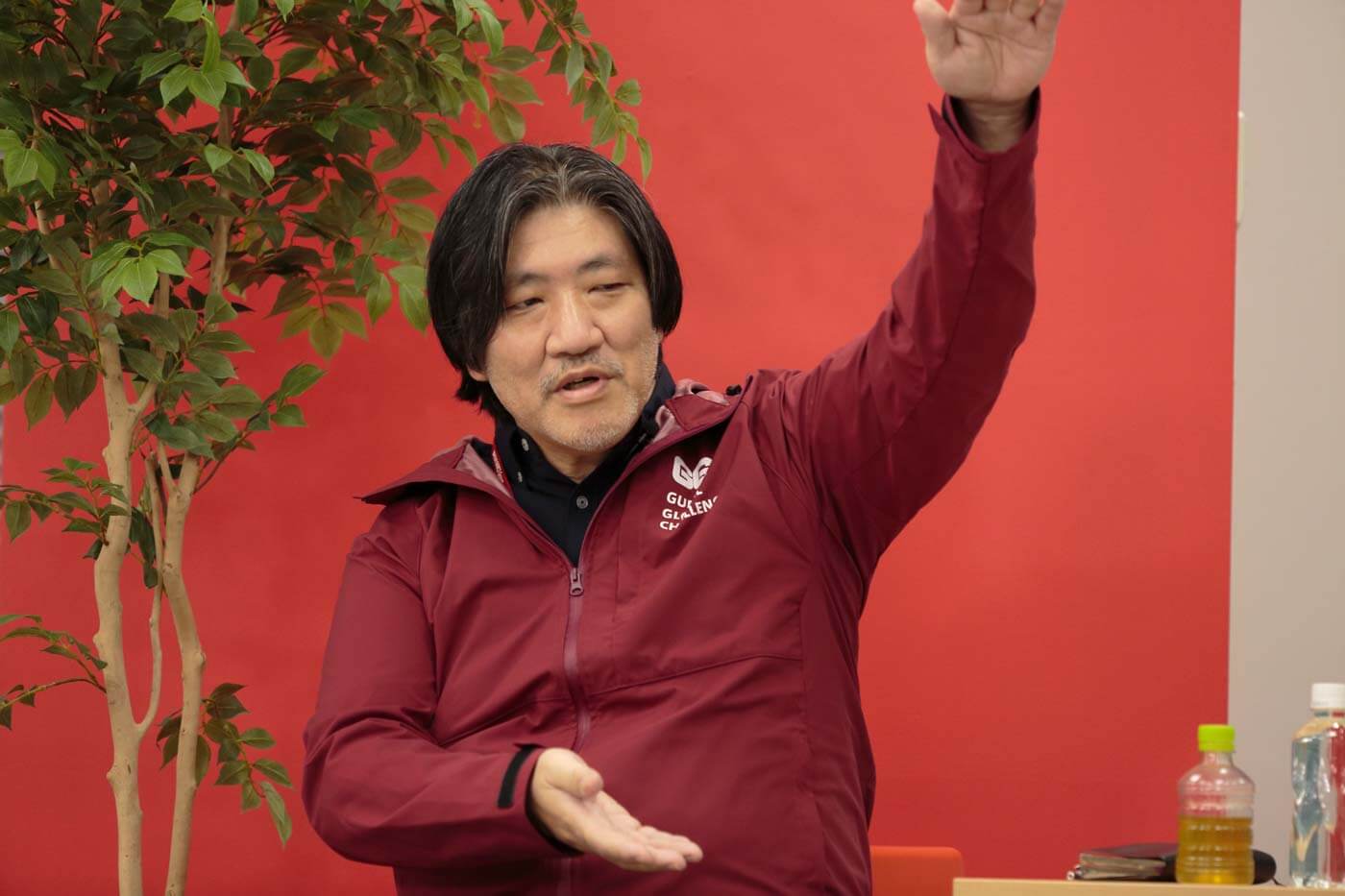
KAWAHARA : It took some time to finalize the direction of the design for "Shiokaze GUNDAM." But there is a specific moment that I made up my mind. Back then, the B747 Jumbo was still in service. One day, I was sitting in a seat close to the Jumbo's wing. Looking at it I noticed that the wing moved quite supplely despite being made of metal.
In addition, the flaps moved during landing, and the area of the wings expanded more than I imagined. The moment I saw that, I thought “This is it!” "Shiokaze GUNDAM" was a standing rendition, but I felt that I had found some answers about the look and details that I needed to make it seem like it was "Moving" without actually "Moving". Another factor was that the Jumbo's wing was actually 20 meters in length. That’s about GUNDAM size.
FUJIWARA : That’s interesting.
KAWAHARA : After that, while actually proceeding with the design, we worked to change the balance of proportions and increase the design density. While referring to GUNPLA models, I was always aware of how the statue would appear as one stood beneath it looking upwards.
One of the things that worked well was the addition of details using different colors. GUNDAM has a lot of white area, so instead of painting it with the same color, I painted it using about 4 colors with different tones. I wanted to ease the monotony by doing so. The hint was the U.S.S. Enterprise of the movie "Star Trek." In the TV version, it was all white, but in the movie version, a fine pattern called the Aztec pattern was added to the hull. I thought that if I did that with GUNDAM, it would look more realistic.
FUJIWARA : Bringing a fantasy character to life while maintaining its image is no easy feat. "Shiokaze GUNDAM" must really hold a lot of significance.
KAWAHARA : That's right. With "Shiokaze GUNDAM," we did some pretty advanced things even in the manufacturing process. First I made a model, scanned it in 3D, modified the data from there, then made a full-scale prototype. This was also in the early days of 3D printers, so I used an excavator to create the prototype. By publishing this process in a “Making of” type compilation, I think that I contributed to raising the level of manufacturing and modeling in Japan. I also heard from Mr. Ishii and Mr. Yoshizaki later that there were quite a few engineers who felt motivated after seeing "Shiokaze GUNDAM." I think the best thing was best that the industry as a whole got excited in that way.
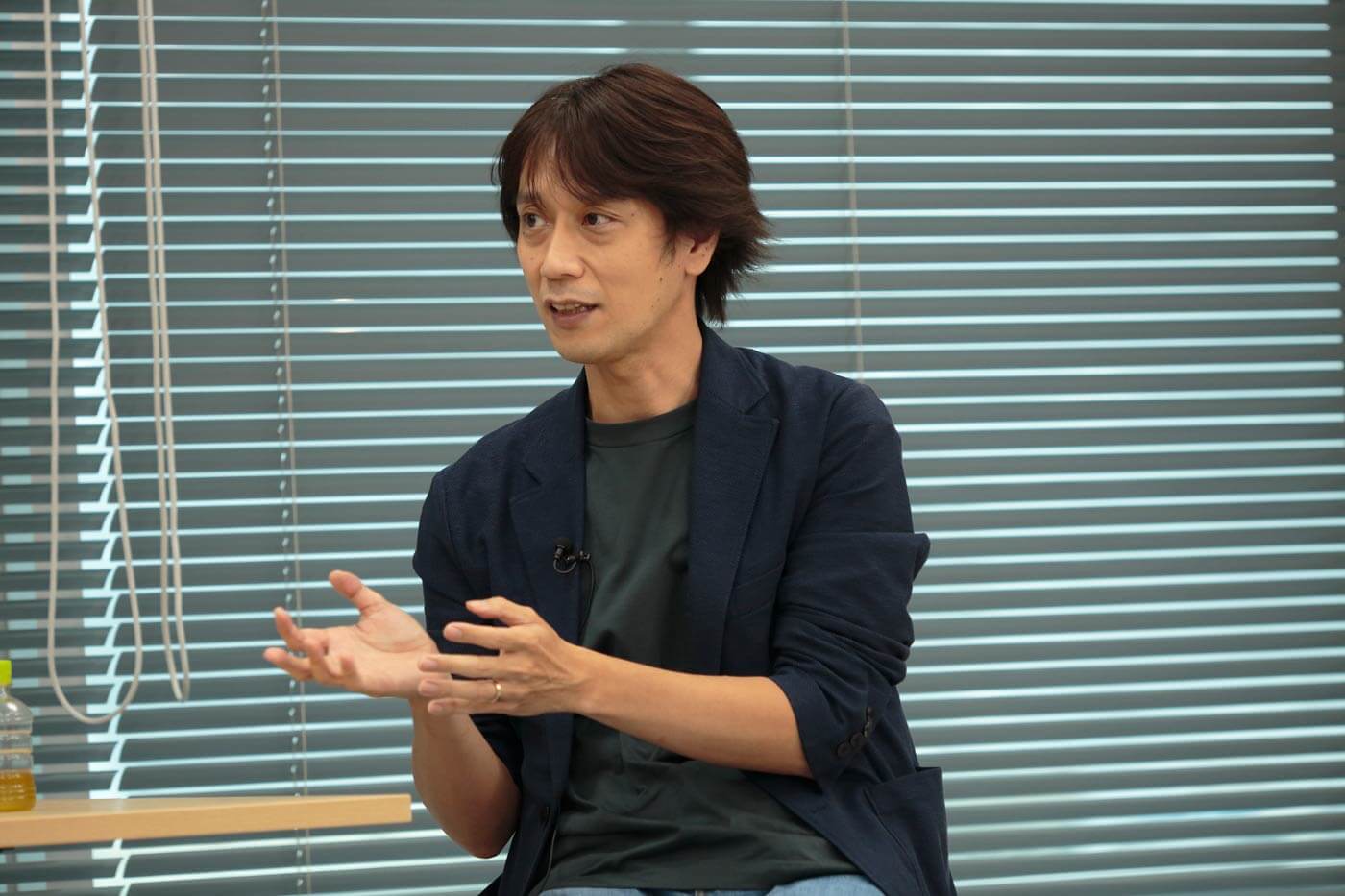
FUJIWARA : Actually, even with regards to GUNPLA, I hadn't thought that deeply about the meaning of panel lines or coloring gradation until then. "Shiokaze GUNDAM" was a great opportunity to improve this area and we not only made the internal frame structure much better, but also the look of the surface density. In that sense, it was a project that had a big impact on GUNPLA too. Right then, how about you, Mr. Yoshizaki?
YOSHIZAKI : I don’t think that anyone will think that GUNDAM is completed by just making a “Moving GUNDAM”. We are still at the development phase. For that reason, it was necessary that parties involved in the project share common recognition as to “What we really want to make,” ”What we want to achieve this time,” and “Ideas for the future.” After all, this is not a project that can be re-created over and over again.
Therefore, in “Moving GUNDAM”, we created contents in advance to verify it. First, we got CG data of GUNDAM from SUNRISE INC. At the same time, we got 2D design drawings from Mr. KAWAHARA. We also got data for CAD from Mr. Ishii. I combined all of these on a game engine so that we can experienice them with a VRHMD. People involved in the project watched this and worked out the details. I think that it was a rather innovative approach back then.
ISHII : That VR was really good. Everyone's morale raised because of it.
YOSHIZAKI : Members of the academic world also participated in the project. Dr. Pitoyo Haltono of Chukyo University was one of them. I said to Dr. Haltono, “People gathered here are all fond of GUNDAM so the motivations of the participating companies must be also high.” Dr. Haltono responded by saying, “Yes, you are right, but that phase has already past.” Yes, it is important that people participate because they are fond of GUNDAM, But when it comes to actually making GUNDAM, you need some degree of commitment. I think he thought that just being fond of GUNDAM is insufficient. The project can takeoff only when fans with determination, commitment get together.
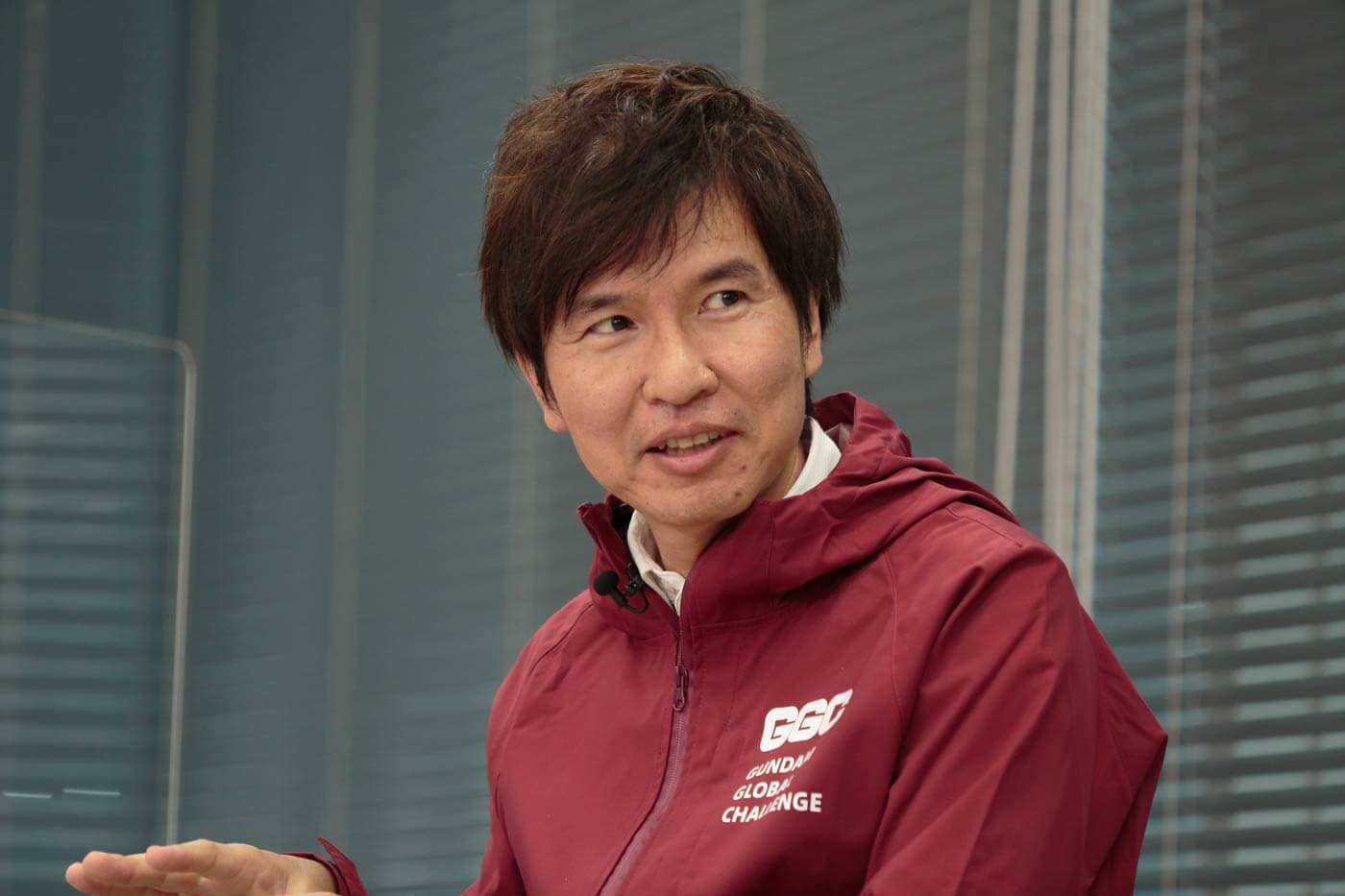
ISHII : 9 companies participated in the “Moving GUNDAM” project as technical partners. About 30 people from these companies held meetings every other week to discuss potential solutions to all kinds of problems and everyone was very positive. In cross-company projects, participants tend to take up positions like “This is as far as my company can take responsibility for and we cannot go beyond this point.” However, in this project, no one hesitated to cross such boundaries. Putting the project together turned out to be rather easy.
FUJIWARA : The difference is quite big. The quality of the completed work can change dramatically just by taking one step closer to each other. I think that each company took a step towards the other companies because everyone involved was so passionate about "Moving GUNDAM." In such circumstances, what did you sense from "Moving GUNDAM," Mr. Ishii?
ISHII : I joined a construction equipment manufacturer after graduating from university because I wanted to build “a robot I can ride and maneuver”. I got involved in designing various aspects of machinery and accumulated know-hows on building large machineries. Then, I saw “Shiokaze Gundam” and was overwhelmed. It made me think that “May be, I can, at least, make that arm move.” I had an occasion to view some SNS postings made then to find posting along similar lines. So when I was invited to join “Moving GUNDAM”, I had an idea that it will be possible to make a properly Moving GUNDAM by cleverly combining existing technologies.
Having said that, I was not really sure as to how far we can take it until we actually tired. At the end, we managed to make a 18m robot move as a mobile suit. To this extent, the value of the project lies in the fact that people from various fields gathered and realized GUNDAM. The team members are normally involved in manufacturing cranes or developing industrial robots. Combining know-hows leading to creation of a Moving GUNDAM was the first such experience for each of us. Everyone seemed to be enjoying the work on hand.
How does Bandai Namco Group position "Moving GUNDAM" and link it in with GOI? Also, if you were to participate in GOI, what would you like to research?
FUJIWARA : Thank you very much for sharing such an interesting story. I really got a strong sense of how passionate everyone is about GUNDAM and the intensity of that power. I was also very encouraged to realize that the power of the fans who support GUNDAM, which I mentioned earlier, has become so strong. At the same time, I was able to understand how Bandai Namco will handle everyone’s love and passion toward GUNDAM will affect whether or not GUNDAM can produce even more power.
Now we are starting an initiative called GOI. At the beginning of the very first episode of GUNDAM, the narrator states "Mankind moved into space to ease the burden of overpopulation." I don't know if that will actually happen, but despite being aired 40 years ago, that line seems to have foreseen the societal issues humanity faces today. As such, at GOI, I would like to firmly address real societal issues and the way we should be in the future from a GUNDAM perspective.
Before GOI, you all worked towards the goal of "Moving GUNDAM". Can you tell me if that experience made you aware of something that could be done with GUNDAM, or if you have any ideas about what you’d like to do if you participated in GOI?
ISHII : GUNDAM was the first Sci-Fi that our generation got exposed to. To cite an example, take the space colony, it's floating in outer space, spinning to artificially generate gravitation force for the people living inside of it. If human beings are moving in that direction, we have nothing but hope. Man kind undertook many ventures and achieved admirable events, such as the Apollo program in exploring outer space. I think we can count the world view of GUNDAM as one of them. Based on such a background, if I were to be asked “What would you like to do in GOI?”, I will definitely say that I want to build a mobile suit. Having built the “Moving GUNDAM”, the next step will be to build something that I can pilot.
The issue will be its size. I talked with Mr. Yoshizaki about this. In order to realize an 18 m robot on earth, we have to take into account the things, such as gravity and laws of physics that we live under. We need to think about how to absorb the energy when a mobile suit falls and hits the ground. One solution is scaling down the size which will possibly allow it to walk.
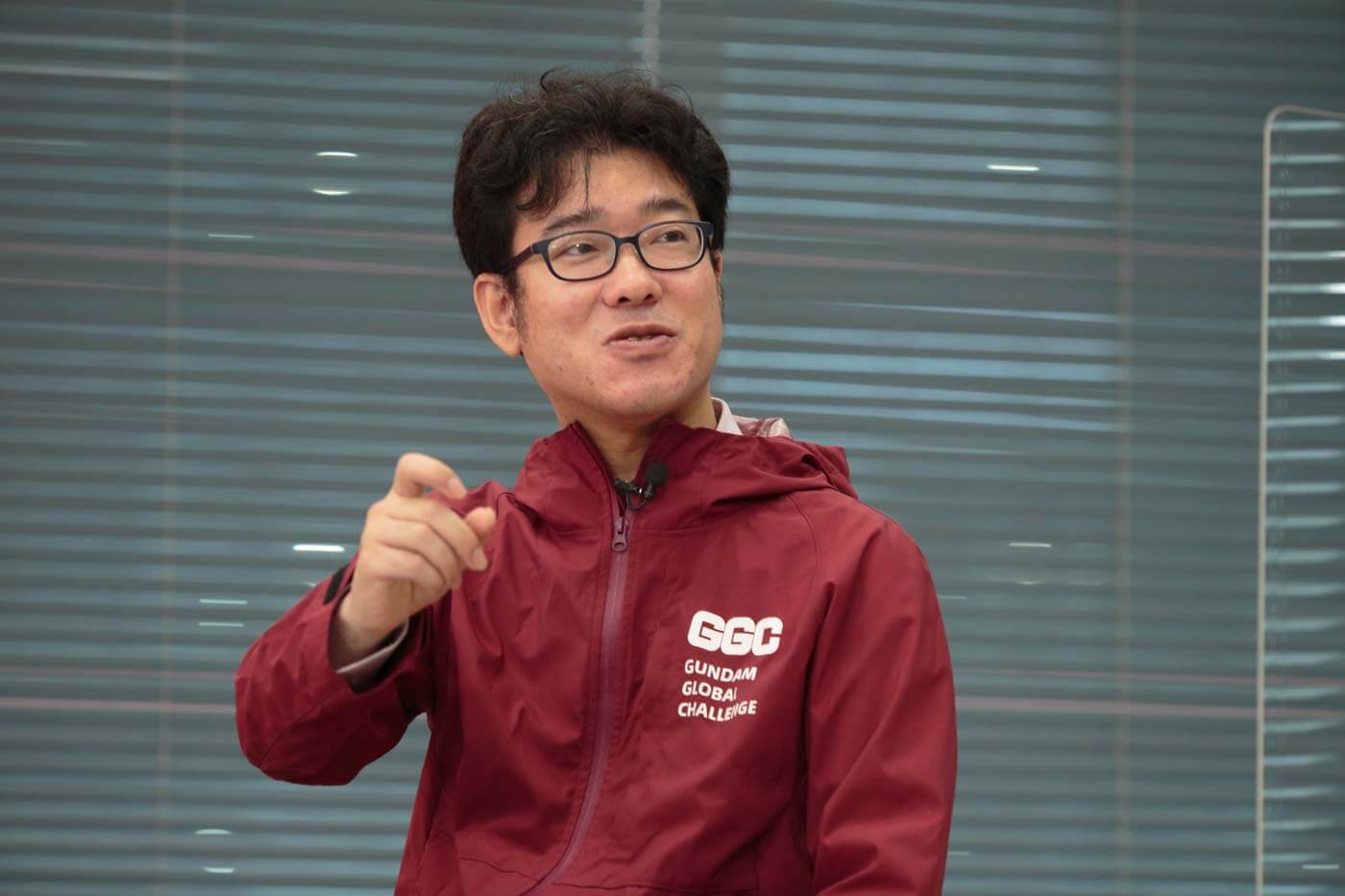
YOSHIZAKI : I often say this, different goals will create different methods. Just for one day, just as a research project, if the floor were leveled, if there is no earthquake, if it was to take just one step; if these were the premises, I wouldn’t say that it is impossible for an 18m robot to be built. However, if I were to make an attempt, I would go with 8m.
KAWAHARA : 8m is a good size
YOSHIZAKI : If I am to get involved, I would like to think about how the fingers will work. In “Moving GUNDAM”, all movements of the parts were predetermined, except the fingers. The fingers were made to move robotically by taking into account external forces acting on them at the time, like slightly different movements if the wind blows. Now in the animation GUNDAM, the 1st episode showed ZAKU using its fingers to pry open a hatch to enter the space colony, and GUNDAM grabbed the heat exhaust duct of ZAKU to pull out the power piping. I am very interested if we can make fingers capable of doing that kind of delicate maneuver, powerful movement or soft touch.
Come to think of it, there are many things that “Moving GUNDAM” fingers can actually do. On the other hand, it can be said that no robotic fingers capable of such refined movements are yet to be developed even on a scale of human hand size. Right now, we are researching and developing fingers robust enough to wield a hammer and, at the same time, possessing dexterity to shave body hair with a razor at our company. It is still difficult to maneuver fingers with capabilities equal to ZAKU, but we might be able to do so in the future. If such fingers are made available and future children can freely engage them, they might evolve to become excellent robot pilots, in a sense similar to growing up being a digital native. Such days may be just around the corner.
FUJIWARA : I think it’d be great if people pursue the GUNDAM theme but instead of simply reproducing scenes from the anime, a world will be a happier place if we did that with deep understanding of GUNDAM's theme. I hope the research you are doing could be combined with GUNDAM to make it more appealing, or make the goals clearer.
KAWAHARA : I think everyone would like to pilot something like a Mobile Suit. On the other hand, from a slightly different point of view, GUNDAM has a lot of charm as a science fiction. The space colony that Mr. Ishii mentioned is one of them. There are also the space elevators that appear in "GUNDAM Reconquista in G". I think that mechanisms such as social infrastructure and the economy are the backbone to the GUNDAM story, and that’s what gives it depth.
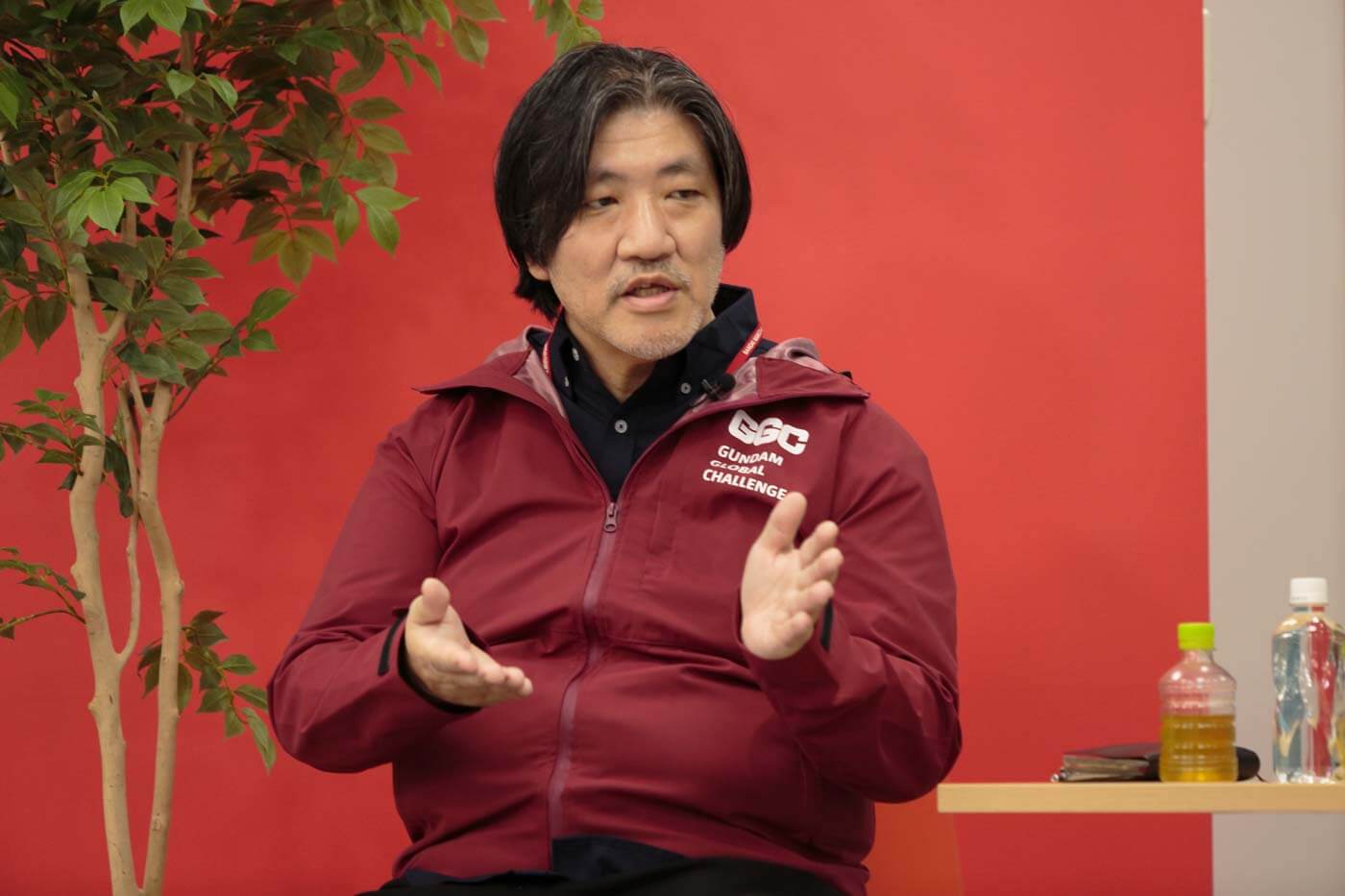
Our main business is spatial design, and that accounts for most of the work I do, so I am interested in mobility of the future and how to utilize spaces. For example, in the space elevator in the anime, it takes three days to travel from the surface of the Earth to the space terminal. If you think about it, three days in an elevator is pretty long. It's very difficult to think about what kind of space it is inside the elevator and what kind of experience a person could have, but it's also interesting and exciting. In this way, I come to notice various aspects when I consider GUNDAM's worldview from the perspective of future infrastructure.
FUJIWARA : How to spend three days in a space elevator may be something that only those who normally think about spatial design notice. There aren’t even any space suits that can move with good flexibility yet. Freeze-drying is the mainstream for space food right now, but in GUNDAM, people eat normal food. If space becomes a place more familiar to humankind in the future, we will have to consider these issues. It's a theme that spreads to the clothing and food industry.
KAWAHARA : Actually, I really want to travel into space someday. Commercial tours have already started, and I would love to be able to look down on Earth from up above someday.
Bandai Namco Group is going to evolve "Mobile Suit GUNDAM" from IP(*1) to SP(*2) through GOI, but what exactly does this entail?
FUJIWARA : Thank you. All of them are interesting themes, and from the viewpoint of GUNDAM, I can see how various themes could be relevant. One of the reasons for promoting GOI at Bandai Namco Group is such social spread. Through GOI, I would like to change the nature of GUNDAM. Our Group often uses the term “IP,” but we want to evolve GUNDAM from IP to SP, so to speak, to be a social icon, or “social property.”
So how does the evolution from IP to SP change GUNDAM? I think the most important thing is a change in the way we face GUNDAM. Until now, as Bandai Namco, we have thought about what GUNDAM should be, output it in the form of products and services, and shared it with customers. However, when it comes to SP, through communicating with fans, we will find out what is best for GUNDAM fans. Here, the common ground is that we are all fans of GUNDAM. We will sincerely consider the proposals of people with such passion, digest them properly, and together consider the ideal form of GUNDAM. That's the SP, or social icon, we envision and how we will face GUNDAM. I feel like there was such an aspect with "Moving GUNDAM." What about you?
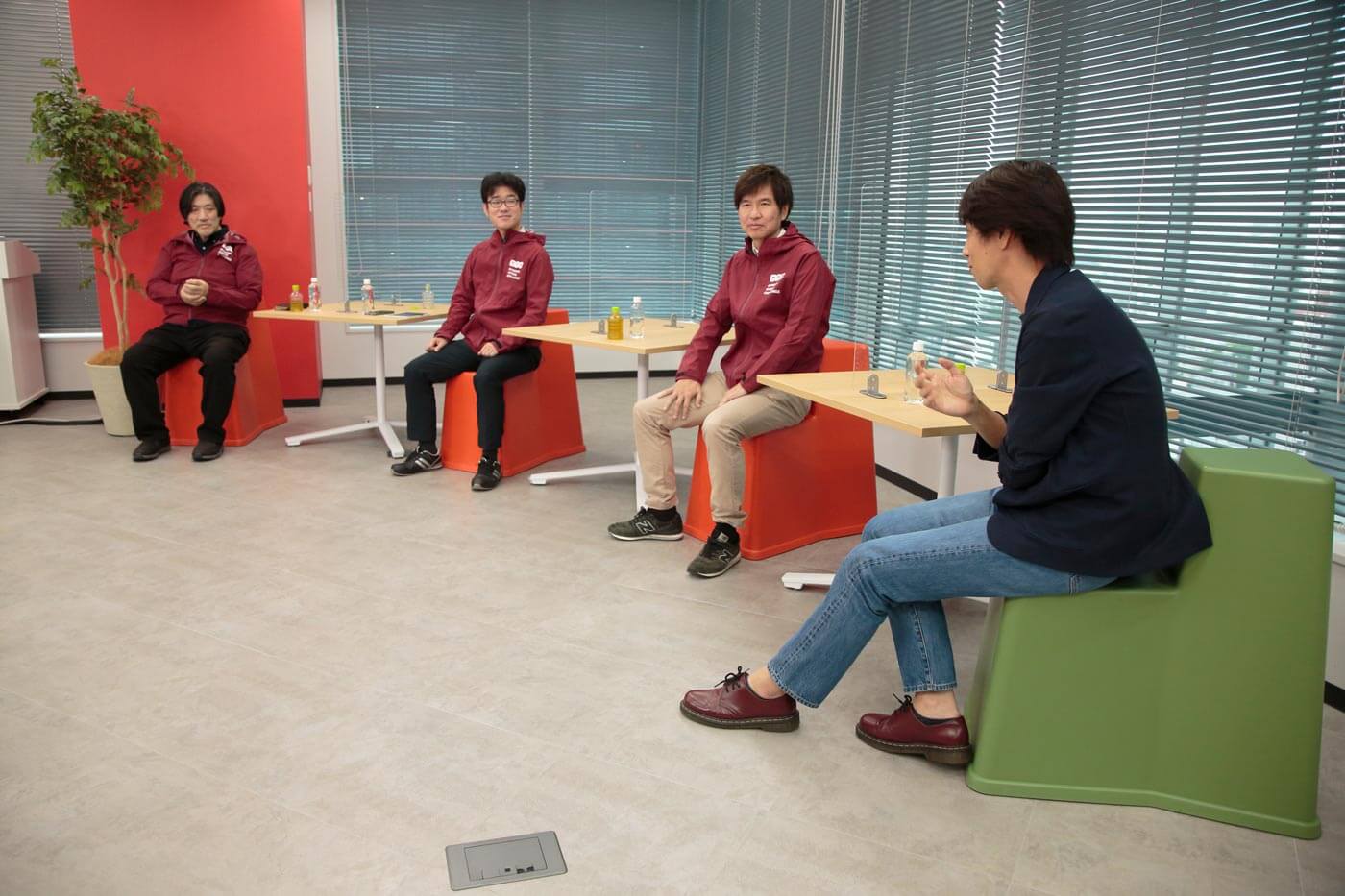
KAWAHARA : In May of this year, the opening ceremony for "Life-size Freedom GUNDAM Statue" appearing in "Mobile Suit GUNDAM SEED" was held in Shanghai. Looking at the local interview videos, it was quite obvious that Chinese people liked GUNDAM as much as Japanese people do. I was very happy and relieved. In other words, the common language of “GUNDAM” was born there. In this way, despite cultural barriers that may exist, GUNDAM can serve as a communication tool, and I think that trend exists in other countries too. Recently, I hear that sales of GUNPLA are growing in the U.S. and Europe due to a demand amidst the COVID pandemic, and, in many ways, I think GUNDAM will become a cultural phenomenon.
What will this be like in the future? I think "Star Wars," for example, is an example of SP in the United States. Professional cosplayers gather to dress up as Imperial troops and visit medical facilities in various places as charity, which also happens in Japan too. I had the thought that if various social contribution activities took place related to GUNDAM, then it would evolve as SP.
YOSHIZAKI : Until now, the term social icon seemed foreign to me. However, as I listened to what Mr. FUJIWARA has to say, I got this feeling that there is a difference between making something exactly as the prepared draft and making something great by exchanging ideas. In “Moving GUNDAM”, individuals with diverse backgrounds got together to build GUNDAM that occupies a entirely new realm. It will be wonderful to extend this to other fields.
Hearing about the story of STARWARS Moving into philanthropic field. That reminded me of a disaster bulletin twitter account called “Special Agency NERV” and its disaster prevention app.(*3) I think it would be really great if GUNDAM could merge with some socially meaningful initiatives. That will make it even more meaningful and increase its power to appeal. If GUNDAM becoming a SP can accelerate such movement, that will be amazing.
ISHII : SNS has accelerated bidirectionality in society. Yesterday, I saw many high-quality photos of “Moving GUNDAM” being posted and triggering many LIKE’s. I think society is moving away from unidirectional structure, which is one-way provision of services or products by companies, to bidirectional, which is communicating back how those services or products are interpreted and evaluated. Given this social environment, it would be natural for Bandai Namco to shift in that direction. And thereby making it possible for GUNDAM to survive long after our generation is gone. It would be really nice if GUNDAM can survive for hundreds of years by becoming a SP.
FUJIWARA : Thank you. As Mr. Ishii said, I think the most important thing in SP is that GUNDAM will being loved for a long time. Naturally, we also consider various ways this could happen, but I think that it is quite difficult with our passion alone. I think that the reason why GUNDAM is supported by so many people is above all the passionate sentiment of GUNDAM fans and the connections that have arisen from that. I want GUNDAM to become something that can naturally be shared in that way.
*1: The abbreviation of Intellectual Property. Intellectual property rights such as game and anime titles and characters.
*2: The abbreviation of Social Property. A new social concept that Bandai Namco Group wants to achieve through GOI.
*3: The name and logo of "Special Agency NERV" are used with the permission of Khara, INC., the copyright holder of the "Evangelion" series, and GroundWorks: INC., which manages the rights to the Evangelion.
Bandai Namco Group has been working on a program called Accelerator Program. It will be grateful if you touch upon the difference between GOI and Accelerator Program and ask for participation to the two programs. Also, could each of you please share your impression of today?
FUJIWARA : Lastly, to elaborate on GOI, Bandai Namco Group has been promoting Accelerator Program to date. We have been working with startups who have new ideas to develop new businesses. Some elements of GOI are very similar to the Accelerator Program, but there is one difference; I hope GOI can produce concrete outputs for actual social implementation. However, I don’t intent to clarify the goal too much, in fact, I believe that making the goal too clear limits ideas.
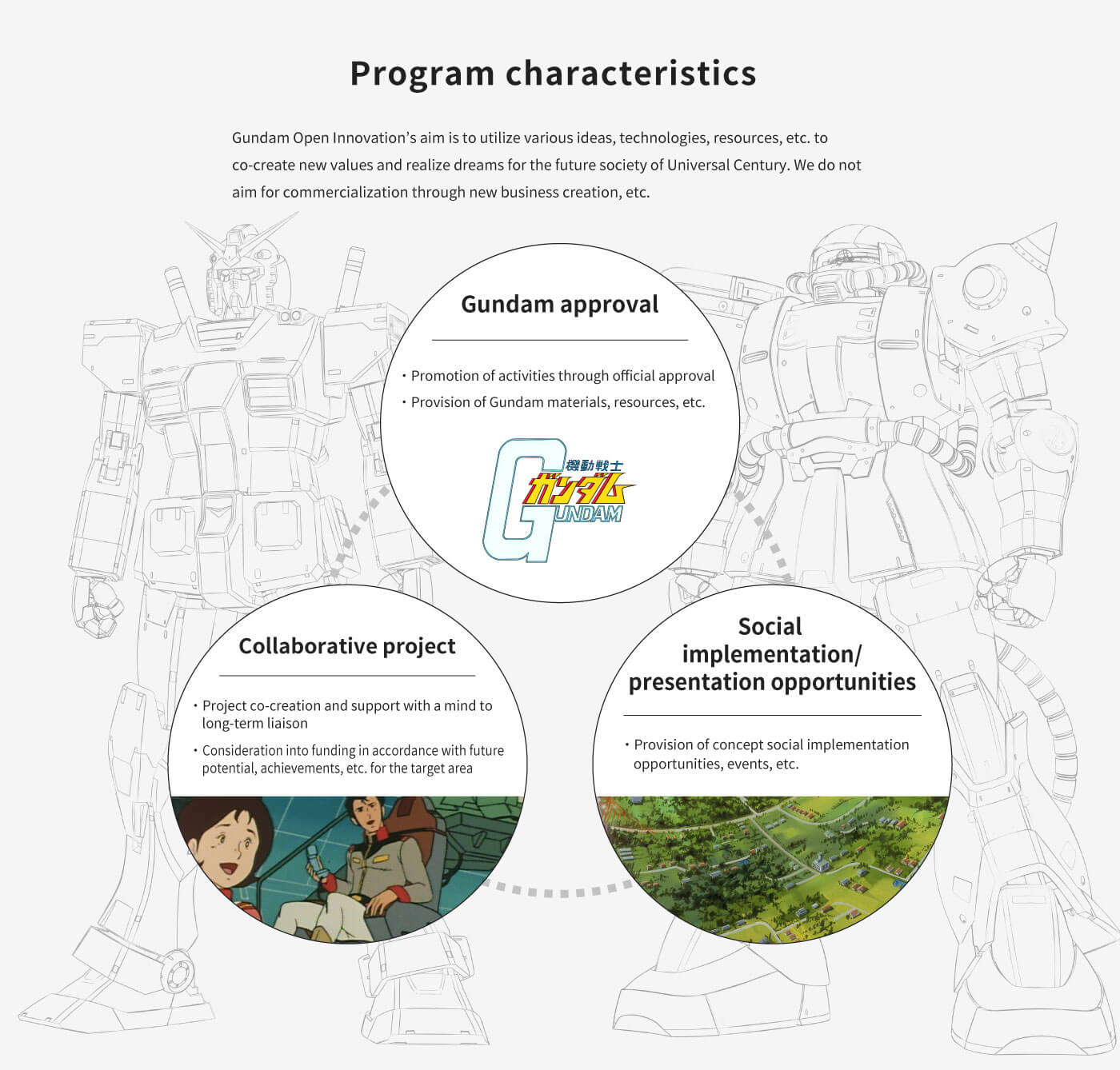
Of course, when judging ideas, I think it is important that some sort of plan is visible. However, we do not necessarily want to apply limitations by saying that such-and-such has to be done by a certain time. Rather, I think the best outcome is that companies or companies and individuals with a fondness of GUNDAM can come together to build relationships through GOI. To that end, rather than a concrete, extremely realistic proposal, I would be very happy if people could make proposals like “GUNDAM could achieve this,” “I can contribute to that cause in this way,” or “The potential increases if we work with Bandai Namco.” What do all of you think?
ISHII : By getting involved with “Moving GUNDAM” I moved from the side of Gundam consumer to the side of Gundam contents provider. This was a very valuable experience for me. I hope that other people can have similar experiences by joining GOI. Thank you having me here today.
YOSHIZAKI : Today, I heard a lot on GOI and felt that the most important point is that this project is initiated by our desire. Through “Moving GUNDAM”, I also experienced many things that I could not otherwise experience. I hope that with GOI, it will become more open and leads to various insights and spread among society. Thank you very much.
KAWAHARA : I was involved in "Moving GUNDAM" for about 5 years, time truly did fly by. Especially in the second half when Mr. Ishii and Mr. Yoshizaki got involved, it was a fun ride compared to the first half. This project offered excitement and wonder because it involved co-creation with a diversity of people and companies I wouldn’t normally get to meet. I'm really looking forward to seeing what GOI can conceive. Thank you very much for today.
FUJIWARA : It gave me high hopes that various ideas would emerge, based on the experiences and thoughts all of you shared with us today. In order to continue to advance GUNDAM, we hope that you will help us with various initiatives based on your knowledge. We will also sincerely address these thoughts. Thank you so much for today.
